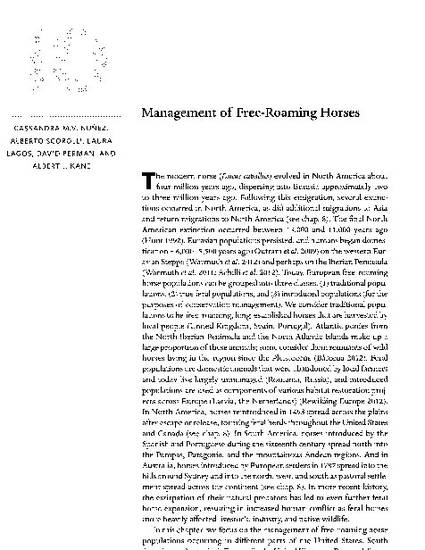
The modern horse (Equus caballus) evolved in North America about four million years ago, dispersing into Eurasia approximately two to three million years ago. Following this emigration, several extinctions occurred in North America, as did additional migrations to Asia and return migrations to North America (see chap. 8). The final North American extinction occurred between 13,000 and 11,000 years ago (Hunt 1992). Eurasian populations persisted, and humans began domestication ~6,000-5 ,500 years ago (Outram et al. 2009) on the western Eurasian Steppe (Warmuth et al. 2012) and perhaps on the Iberian Peninsula (Warmuth et al. 2011; Achilli et al. 2012). Today, European free-roaming horse populations can be grouped into three classes: (1) traditional popu· lations, (2) true feral populations, and (3) introduced populations (for the purposes of conservation management). We consider traditional popu· lations to be free-roaming, long-established horses that are harvested by local people (United Kingdom, Spain, Portugal). Atlantic ponies from the North Iberian Peninsula and the North Atlantic Islands make up a large proportion of these animals; some consider them remnants of wild horses living in the region since the Pleistocene (Barcena 2012). Feral populations are domestic animals that were abandoned by local farmers and today live largely unmanaged (Romania, Russia), and introduced populations are used as components of various habitat restoration proj· ects across Europe (Latvia, the Netherlands) (Rewilding Europe 2012). In North America, horses reintroduced in 1493 spread across the plains after escape or release, forming feral herds throughout the United States and Canada (see chap. 8). In South America, horses introduced by the Spanish and Portuguese during the sixteenth century spread north into the Pampas, Patagonia, and the mountainous Andean regions. And in Australia, horses introduced by European settlers in 1787 spread into the hills around Sydney and into the north, west, and south as pastoral settlement spread across the continent (see chap. 8). In more recent history, the extirpation of their natural predators has led to even further feral horse expansion, resulting in increased human conflict as feral horses more heavily affected livestock, industry, and native wildlife.
Available at: http://works.bepress.com/cassandra_nunez/11/

This is a chapter from Nuñez, C.M.V., A. Scorolli, L. Lagos, D. Berman, A. Kane. 2016. Management of freeroaming horses in J.I. Ransom and P. Kaczensky, eds. Wild Equids. The Johns Hopkins University Press.